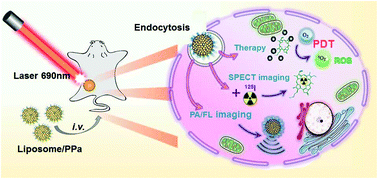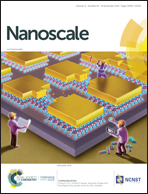Plant-derived chlorophyll derivative loaded liposomes for tri-model imaging guided photodynamic therapy†
Abstract
Plant-derived chlorophyll derivatives with a porphyrin ring structure and intrinsic photosynthesis have been widely used in biomedicine for cancer theranostics. Owing to their poor water solubility, chlorophyll derivatives are very difficult to use in biomedical applications. In this work, pyropheophorbide acid (PPa) (liposome/PPa) nanoparticles, a liposome-encapsulated chlorophyll derivative, are designed for tri-model imaging guided photodynamic therapy (PDT) of cancer. The obtained liposome/PPa nanoparticles significantly enhance the water solubility of PPa, prolong blood circulation and optimize the bio-distribution in mice after intravenous injection. Utilizing their intrinsic fluorescence, high near-infrared (NIR) absorbance and extra radiolabeling, liposome/PPa nanoparticles could be used as excellent contrast agents for multimodal imaging including fluorescence (FL) imaging, photoacoustic (PA) imaging and SPECT/CT imaging. Under 690 nm laser irradiation at a low power density, liposome/PPa nanoparticles significantly inhibit tumor growth, further demonstrating the therapeutic efficiency of PDT using PPa. Therefore, our work developed liposome/PPa nanoparticles as multifunctional nanoagents for multimodal imaging guided PDT of cancer. This will further prompt the clinical applications of PPa in the future.

- This article is part of the themed collection: 2019 Nanoscale HOT Article Collection


 Please wait while we load your content...
Please wait while we load your content...